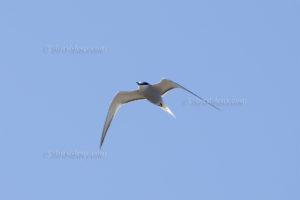 The cute, delicate Aleutian Tern (Onychoprion aleuticus, formerly Sterna aleutica) breeds entirely in the north Pacific Ocean on the coasts of Sakhalin and Kamchatka, Russia, on islands in the Bering Sea and on the Aleutian Islands. A recent BirdLife article from November 22, 2016 by Andy Symes asks whether this species has to be uplisted to Vulnerable or Endangered.
The cute, delicate Aleutian Tern (Onychoprion aleuticus, formerly Sterna aleutica) breeds entirely in the north Pacific Ocean on the coasts of Sakhalin and Kamchatka, Russia, on islands in the Bering Sea and on the Aleutian Islands. A recent BirdLife article from November 22, 2016 by Andy Symes asks whether this species has to be uplisted to Vulnerable or Endangered.
Aleutian Tern is currently listed as Least Concern on the basis that it was not thought to approach the thresholds for Vulnerable under any of the IUCN Red List criteria. A 2013 status assessment by the U.S. Fish and Wildlife Service compiled new data on Alaskan colonies and suggested that the population at surveyed colonies had declined by 79% since 1995, with perhaps fewer than 5,000 individuals – down from 9,000 to 12,000 birds – in Alaska as a whole.
Recent studies show however, that the majority of the world’s population of Aleutian terns now nest in the Russian Far East, especially the northern end of Sakhalin Island which may host 2/3 of the world’s population. Up to now, most the colonies in Russia are barely fully documented and are based mainly on quantitative estimate. Anyway Numbers in some regions in Russia appear to have increased substantially in recent decades, especially on Sakhalin Island and the southern coast of the Koryak Highland.
Unfortaunetly, most of these places are very remote and very little monitoring takes places so trend information is lacking completely. The impression is however that the species has declined quite strongly and a monitoring plan needs to be developed. The species is at least near threatened but most likely vulnerable. More monitoring in Kamchatka and Sakhalin is requested.
This species could be seen during a trip to Nome on the Seward Peninsula along the Nome river mouth. Here the Aleutian Tern seemed to be quite numerous outnumbering Arctic Tern (Sterna paradisaea) by far. The place to look for the species is from the Nome River Bridge where you can obtain an excellent view to the Estuary to the south. The bridge marks a mixing zone where fresh river water meets tidal salt water and turns brackish. This creates a blend of water types and habitats and attracts many different birds to areas of open water or the mud-bar edges of islands. Shorebirds and Gulls were abundant. Even unusual species like Hudsonian Godwit (Limosa haemastica) and Rufous-necked Stint (Calidris ruficollis) were present.
To cope with the growing demand for top shots of the rarer species of the Palearctic Bird-Lens is keen to enrich the range of pictures of birds you can find in the Western Palearctic. Trips to remote places to capture images of rare birds of Western Palearctic were very successful. The nice images you find in the gallery are only a first impression, what you will find in the gallery in the “Picture Shop” very soon. Just give me a message, if bird-lens.com could serve you with an image needed before the new pictures are online.